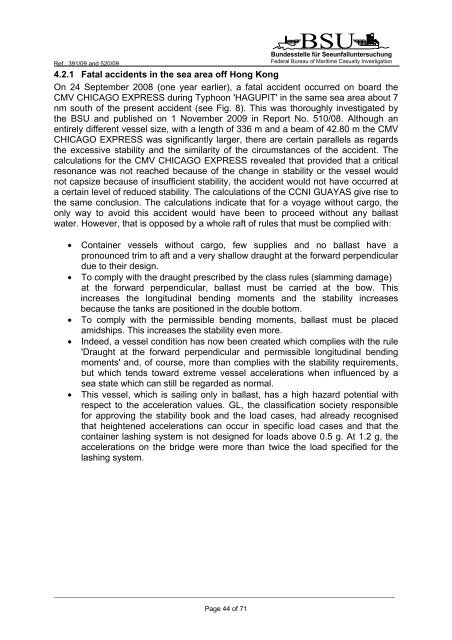SUB-COMMITTEE ON STABILITY AND LOAD LINES AND ON ...
SUB-COMMITTEE ON STABILITY AND LOAD LINES AND ON ...
SUB-COMMITTEE ON STABILITY AND LOAD LINES AND ON ...
Create successful ePaper yourself
Turn your PDF publications into a flip-book with our unique Google optimized e-Paper software.
Ref.: 391/09 and 520/09<br />
BSU<br />
Bundesstelle für Seeunfalluntersuchung<br />
Federal Bureau of Maritime Casualty Investigation<br />
4.2.1 Fatal accidents in the sea area off Hong Kong<br />
On 24 September 2008 (one year earlier), a fatal accident occurred on board the<br />
CMV CHICAGO EXPRESS during Typhoon 'HAGUPIT' in the same sea area about 7<br />
nm south of the present accident (see Fig. 8). This was thoroughly investigated by<br />
the BSU and published on 1 November 2009 in Report No. 510/08. Although an<br />
entirely different vessel size, with a length of 336 m and a beam of 42.80 m the CMV<br />
CHICAGO EXPRESS was significantly larger, there are certain parallels as regards<br />
the excessive stability and the similarity of the circumstances of the accident. The<br />
calculations for the CMV CHICAGO EXPRESS revealed that provided that a critical<br />
resonance was not reached because of the change in stability or the vessel would<br />
not capsize because of insufficient stability, the accident would not have occurred at<br />
a certain level of reduced stability. The calculations of the CCNI GUAYAS give rise to<br />
the same conclusion. The calculations indicate that for a voyage without cargo, the<br />
only way to avoid this accident would have been to proceed without any ballast<br />
water. However, that is opposed by a whole raft of rules that must be complied with:<br />
• Container vessels without cargo, few supplies and no ballast have a<br />
pronounced trim to aft and a very shallow draught at the forward perpendicular<br />
due to their design.<br />
• To comply with the draught prescribed by the class rules (slamming damage)<br />
at the forward perpendicular, ballast must be carried at the bow. This<br />
increases the longitudinal bending moments and the stability increases<br />
because the tanks are positioned in the double bottom.<br />
• To comply with the permissible bending moments, ballast must be placed<br />
amidships. This increases the stability even more.<br />
• Indeed, a vessel condition has now been created which complies with the rule<br />
'Draught at the forward perpendicular and permissible longitudinal bending<br />
moments' and, of course, more than complies with the stability requirements,<br />
but which tends toward extreme vessel accelerations when influenced by a<br />
sea state which can still be regarded as normal.<br />
• This vessel, which is sailing only in ballast, has a high hazard potential with<br />
respect to the acceleration values. GL, the classification society responsible<br />
for approving the stability book and the load cases, had already recognised<br />
that heightened accelerations can occur in specific load cases and that the<br />
container lashing system is not designed for loads above 0.5 g. At 1.2 g, the<br />
accelerations on the bridge were more than twice the load specified for the<br />
lashing system.<br />
_____________________________________________________________________________________________________<br />
Page 44 of 71
















